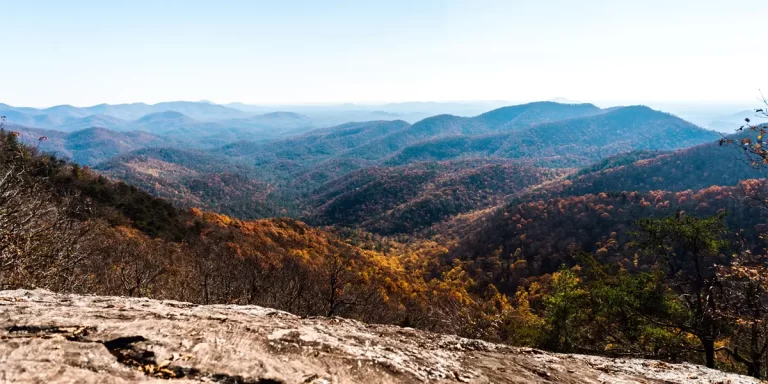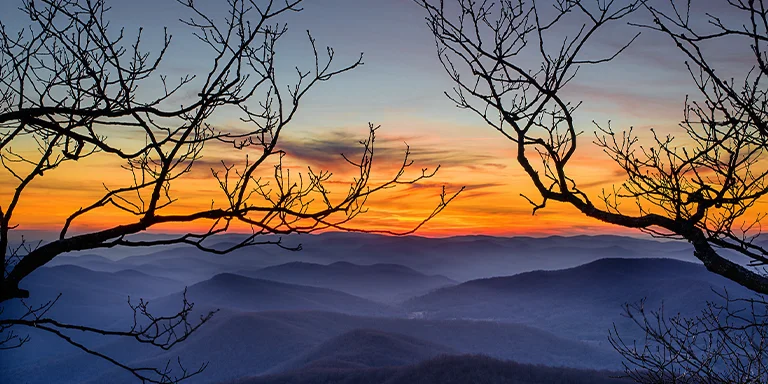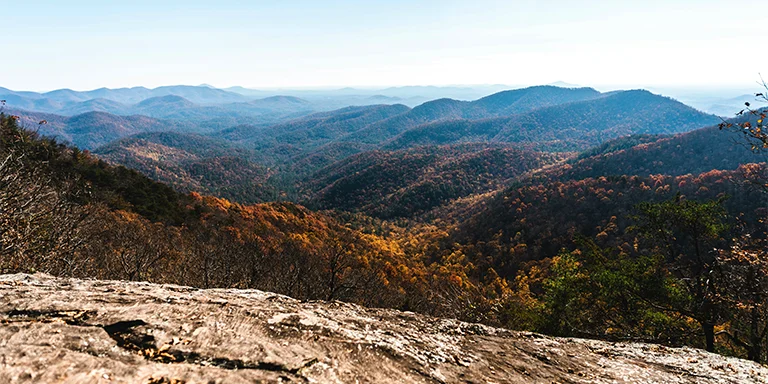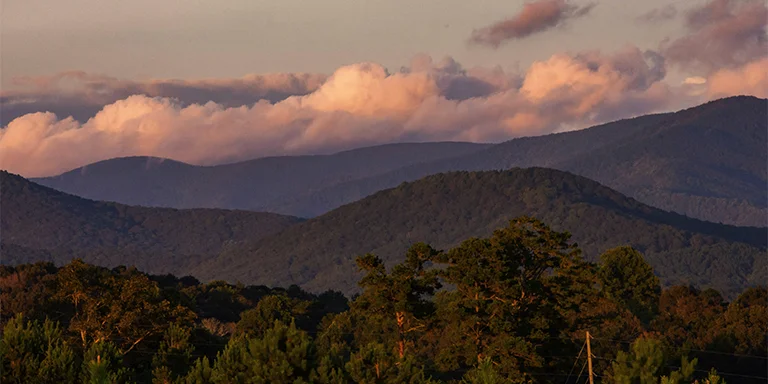

Backpacking in Georgia offers immense variety for outdoor enthusiasts, from the rugged slopes of the Appalachian Mountains to the lush forests of Chattahoochee-Oconee National Forest, including popular destinations like the Appalachian Trail and Benton MacKaye Trail.
And that’s what this post is all about – backpacking in Georgia. We’ll provide tips to help you prepare for backpacking in this diverse state as well as showcase the TOP 5 multi-day trails in Georgia.
Interested? Let’s get started.
Explore Georgia’s best scenic long trails for epic adventures, featuring diverse wildlife:

Photo by Anish Patel, flickr via CC BY 2.0
Length: 29.3 mi / 47.2 km
Type: Point to point
Difficulty: Hard
Elevation Gain: 6417 ft / 1956 m
Location: Blue Ridge Wildlife Management Area
Estimated Hiking Calorie Burn: 6915 calories
More Details: See on AllTrails
Trek 29 scenic miles along the Appalachian Trail from Springer Mountain to Neel Gap on this challenging Georgia backpacking route. Prepare for steep climbs past rock outcroppings with panoramic views, including the 4,400 ft summit of Blood Mountain. Spend nights at shelters and campsites tucked in forest clearings. Fill up on water at springs and creeks. Watch for wildlife like black bears, deer, grouse and wild turkeys. Take side trips to waterfalls and swimming holes. Feel immersed in nature as you journey through hardwood forests and along ridges with nonstop vistas. With its rugged terrain and remote setting, this stretch of the AT makes for an epic overnight backpacking adventure.

Length: 78.2 mi / 125.8 km
Type: Point to point
Difficulty: Hard
Elevation Gain: 18 389 ft / 5605 m
Location: Blue Ridge Wildlife Management Area
Estimated Hiking Calorie Burn: 18 600 calories
More Details: See on AllTrails
Trek 78 miles along the Appalachian Trail through northern Georgia from Springer Mountain to the North Carolina border. Begin at the AT’s southern terminus and make your way through lush forests and across rugged ridges in the Chattahoochee National Forest. Climb to panoramic views from peaks like 4,458 ft Blood Mountain. Spend nights at secluded shelters and campsites. Fill up on water from cold mountain springs. Watch for wildlife including bears, deer and wild turkeys. After 10+ days immersed in nature, complete a significant section of this iconic long distance trail.

Length: 27.3 mi / 43.9 km
Type: Point to point
Difficulty: Hard
Elevation Gain: 6187 ft / 1886 m
Location: Amicalola Falls State Park
Estimated Hiking Calorie Burn: 6500 calories
More Details: See on AllTrails
Hike 27 scenic miles along the Appalachian Trail through northern Georgia’s Chattahoochee National Forest. Begin with the challenging 8-mile Approach Trail up Amicalola Falls, then continue through lush forests and across rugged ridges. Ascend peaks like Big Cedar Mountain and Hawk Mountain for panoramic views. Spend nights at secluded shelters and campsites. Fill water bottles at cold mountain springs and streams. Watch for wildlife including deer, grouse and wild turkeys.

Length: 25.1 mi / 40.4 km
Type: Point to point
Difficulty: Hard
Elevation Gain: 5698 ft / 1 737 m
Location: Warwoman Wildlife Management Area
Estimated Hiking Calorie Burn: 6000 calories
More Details: See on AllTrails
Trek deep into the remote wilderness of North Georgia on this challenging 25+ mile out-and-back trail. Begin along the banks of Wilson Creek, then make your way uphill through dense forests with rocky outcroppings. Pass booming waterfalls and swirling rapids as you follow the creek’s path. Watch for wildlife like deer, grouse and black bears. Find perfect backcountry campsites and fill up on water as you go. Traverse up and down steep terrain, passing panoramic overlooks along the way. After 2-3 days immersed in nature, culminate your journey with majestic views from Rabun Bald before returning to civilization

Length: 38 mi / 61.2 km
Type: Point to point
Difficulty: Hard
Elevation Gain: 8576 ft / 2614 m
Location: Cohutta Wilderness
Estimated Hiking Calorie Burn: 9150 calories
More Details: See on AllTrails
Journey deep into the remote Cohutta Wilderness on this challenging 38 mile out-and-back trail. Begin at Dally Gap and follow the Jacks River, crossing brisk streams and passing booming waterfalls. Trek through hardwood forests and scenic meadows once home to historic mountain homesteads. Watch for black bears, deer, wild turkeys and other wildlife. Find reliable springs and creeks to replenish water. Traverse overgrown trails, blowdowns, rocky terrain and root systems. After 2-3 days immersed in nature, culminate at the Double Hogpen Gap trailhead before returning to civilization from this scenic wilderness adventure.
Here is a summary of the average annual weather in Georgia:
So in summary, plan for mild conditions in spring and fall but hot sun and storms in summer. Winter brings occasional chills/precip but is generally moderated by the Southern climate.
Before you grab your backpack and head to the trailhead, take a look at the annual weather averages for Georgia (Jasper):
| Jan | Feb | Mar | Apr | May | Jun | Jul | Aug | Sep | Oct | Nov | Dec | |
|---|---|---|---|---|---|---|---|---|---|---|---|---|
| High °F | 50 | 54 | 63 | 71 | 77 | 84 | 87 | 86 | 80 | 70 | 61 | 53 |
| Low °F | 33 | 36 | 42 | 49 | 57 | 64 | 67 | 66 | 60 | 50 | 41 | 36 |
| Rain/Snow (D*) | 9 | 9 | 10 | 9 | 11 | 12 | 13 | 11 | 8 | 7 | 8 | 9 |
Not sure if Georgia is right for you?
Don’t forget to check out our backpacking guide for Tennessee.
Campfires are usually allowed when backpacking in Georgia’s state parks and forests, with some restrictions. Fires must be built in established fire rings where available at designated campsites. During times of high fire danger, usually in late spring through early fall, open burning may be prohibited. It’s best to check the fire danger level and any burn bans before your trip.
To avoid surprising animals, make noise while hiking like clapping or talking. Properly store food and scented items in a bear canister or hung bag to discourage wildlife from campsites. Give snakes and other creatures space if encountered on the trail. If you see a black bear, back away slowly without running or direct eye contact. Give venomous snakes wide berth and snap sticks as you walk. Wear insect repellent and proper clothing to avoid bug bites. Never feed or approach wildlife. Make noise at night if in bear country.
Discover adventure in the lush nature of Georgia’s backcountry but stay safe on rugged trails. Before embarking, acquire a detailed map and inform companions of your route through winding wilderness. Pack bright clothing, first-aid supplies, flashlights, and whistles in case the terrain turns hazardous. Stay hydrated and watch footing on slippery rocks near rivers. Make noise to avoid startling bears, snakes or other wildlife hidden in the forests. Clean your cooking area, food sealed and suspended at night to keep scent down. With adequate provisions and preventative precautions, you can revel in Georgia’s natural beauty while backpacking. Focus on preparation, caution and responsibility so that nature’s call can be answered fully but smartly within Georgia’s forests, mountains and wetlands. Stay found, stay prepared, and prioritize safety to maximize your backpacking experience in Georgia’s great outdoors.
Backpackers traveling through Georgia’s diverse terrain on multi-day trips will find an abundance of water sources available along trails to replenish supplies while exploring. Long distance trekking routes crisscrossing the Appalachian Mountains boast flowing creeks, streams and rivers readily accessible at regular intervals where backpackers can filter water for camping and daily use. Even in the hot summer months when undertaking strenuous backpacking trips through forests and parks, reliable natural hydration is plentiful thanks to the region’s annual rainfall. Proper water treatment and storage allows trekkers to confidently embark on independent travel for wilderness exploration without concern for staying hydrated during their Georgia backpacking adventures.